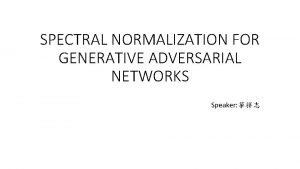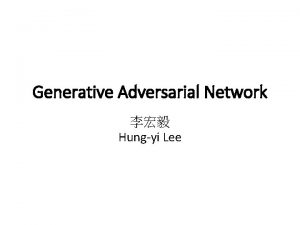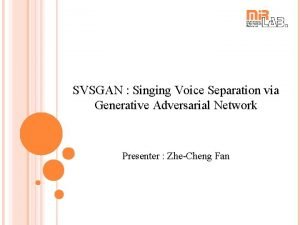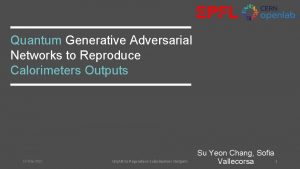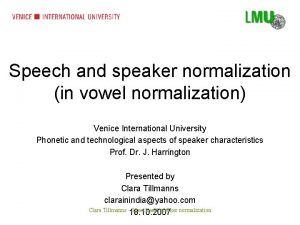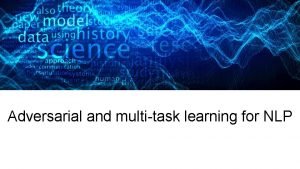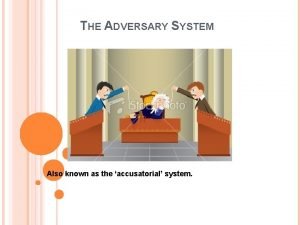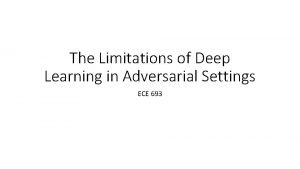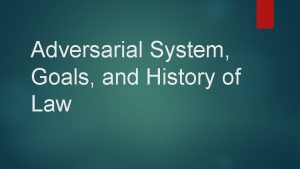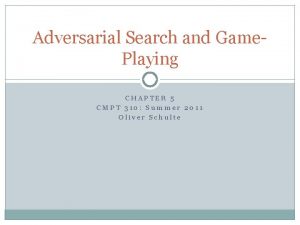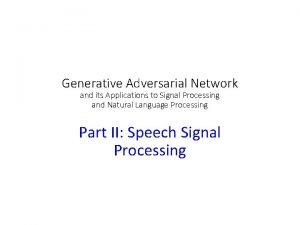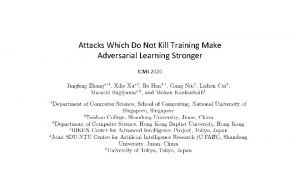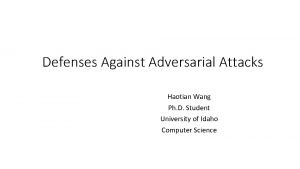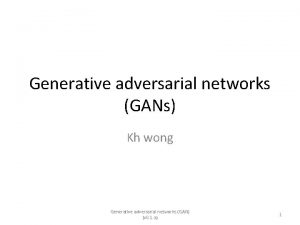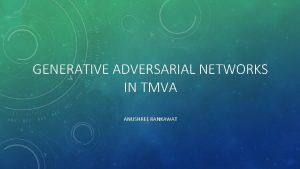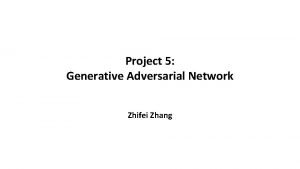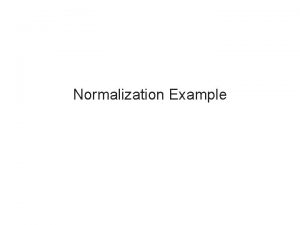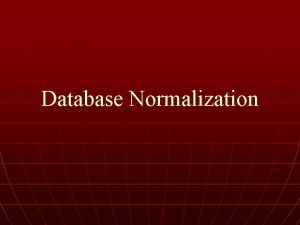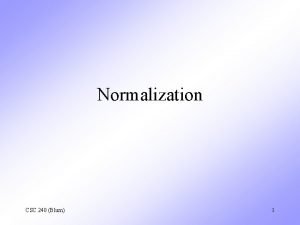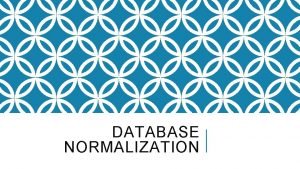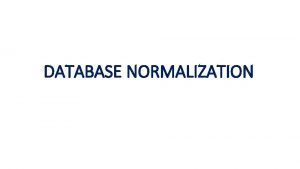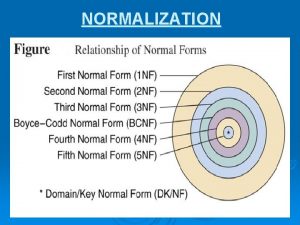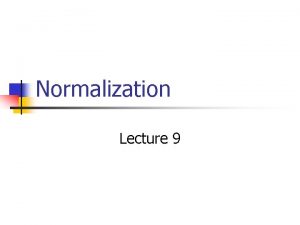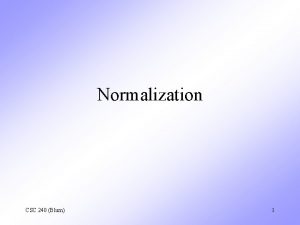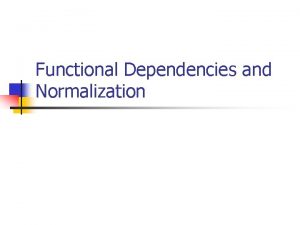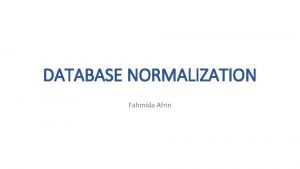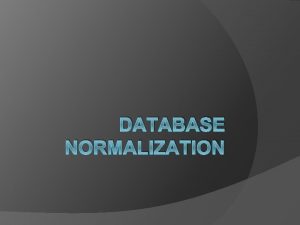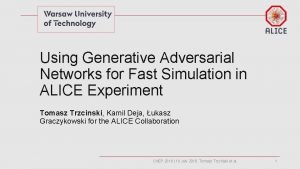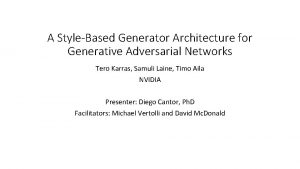SPECTRAL NORMALIZATION FOR GENERATIVE ADVERSARIAL NETWORKS Speaker Outline





















![Reference [1] Miyato, Takeru, et al. "Spectral normalization for generative adversarial networks. " ar. Reference [1] Miyato, Takeru, et al. "Spectral normalization for generative adversarial networks. " ar.](https://slidetodoc.com/presentation_image_h2/40840523d29574e05151d7da1cf2e8ea/image-22.jpg)
- Slides: 22

SPECTRAL NORMALIZATION FOR GENERATIVE ADVERSARIAL NETWORKS Speaker: 華祥志

Outline • Introduction of GAN • Spectral Normalization • Results on CIFAR-10 and STL-10 • Conclusion

Generative Adversarial Network (GAN)

Generative Adversarial Network (GAN) • Generated bedrooms

Generative Adversarial Network (GAN) • Style Transfer

Disadvantages • Non-convergence: the model parameters oscillate, destabilize and never converge • Mode collapse: the generator collapses which produces limited varieties of samples • Diminished gradient: the discriminator gets too successful that the generator gradient vanishes and learns nothing • Unbalance between the generator and discriminator causing overfitting • Highly sensitive to the hyperparameter selections.

Notations • Discriminator network • x : input image • , learning parameters set • ak : element-wise non-linear activation function • Final output of the discriminator

Objective function • The standard formulation of GANs = • Usually • x is real image, x’ is fake image

Lipschitz continuous • • , for any x, x’ = the smallest possible value M • f = Re. LU, leaky Re. LU •

Spectral norm • For matrix A, spectral norm which is equivalent to the largest singular value of A • Each layer • Linear layer

Spectral norm • • are all equal to 1, (e. g. leaky Re. LU) • Upper bound on

Spectral Normalization (SN) • Normalizes the spectral norm of the weight matrix W • is bounded from above by 1 • Use power method to produce the first left and right singular vectors • Approximate the spectral norm by

Gradient •

Algorithm with spectral normalization

Accuracy • Spectral norms of all 7 convolutional layers in the standard CNN during course of the training on CIFAR-10

Results on CIFAR-10 and STL-10 • Weight clipping (WC) • WGAN-GP • Batch normalization (BN) • Layer normalization (LN) • Weight normalization (WN) • Orthonormal regularization • SN-GAN

Results on CIFAR-10 and STL-10 • Hyper-parameter settings • : learning rate • : first, second order momentum (Adam Optimizer) • : number of updates of the discriminator per one update of the generator

Inception Score • Image Quality & Image Diversity • higher is better

Frechet Inception Distance (FID) • • • lower is better are the mean and covariance matrix

Training time • Computational time for 100 updates

Conclusion • Spectral normalization (SN) as a stabilizer of training of GANs. • The generated examples are more diverse than the conventional weight normalization and achieve better or comparative inception scores relative to previous studies. • The method imposes global regularization on the discriminator as opposed to local regularization introduced by WGAN-GP, and can possibly used in combinations.
![Reference 1 Miyato Takeru et al Spectral normalization for generative adversarial networks ar Reference [1] Miyato, Takeru, et al. "Spectral normalization for generative adversarial networks. " ar.](https://slidetodoc.com/presentation_image_h2/40840523d29574e05151d7da1cf2e8ea/image-22.jpg)
Reference [1] Miyato, Takeru, et al. "Spectral normalization for generative adversarial networks. " ar. Xiv preprint ar. Xiv: 1802. 05957 (2018). [2] Goodfellow, Ian, et al. "Generative adversarial nets. " Advances in neural information processing systems. 2014. [3] Gulrajani, Ishaan, et al. "Improved training of wasserstein gans. " Advances in neural information processing systems. 2017. [4] Warde-Farley, David, and Yoshua Bengio. "Improving generative adversarial networks with denoising feature matching. " (2016). [5] Radford, Alec, Luke Metz, and Soumith Chintala. "Unsupervised representation learning with deep convolutional generative adversarial networks. " ar. Xiv preprint ar. Xiv: 1511. 06434 (2015).
 Spectral normalization
Spectral normalization Generative adversarial networks
Generative adversarial networks Oren freifeld
Oren freifeld Generative adversarial network
Generative adversarial network Quantum generative adversarial learning
Quantum generative adversarial learning Speaker normalization
Speaker normalization A switched wan is normally implemented as a network
A switched wan is normally implemented as a network Backbone networks in computer networks
Backbone networks in computer networks Outline speaker
Outline speaker Multi task learning nlp
Multi task learning nlp What is an adversary system
What is an adversary system The limitations of deep learning in adversarial settings
The limitations of deep learning in adversarial settings Adversarial system law definition
Adversarial system law definition Adversarial training
Adversarial training Sigir 2018
Sigir 2018 Adversarial patch
Adversarial patch Adversarial search problems uses
Adversarial search problems uses Adversarial stakeholders
Adversarial stakeholders Adversarial training
Adversarial training Friendly adversarial training
Friendly adversarial training Adversarial examples
Adversarial examples Adversial system
Adversial system Certified defenses against adversarial examples
Certified defenses against adversarial examples
